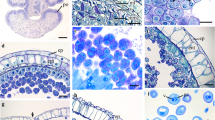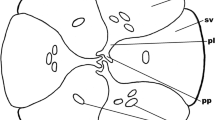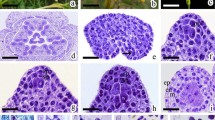Abstract
This study addresses gaps in our understanding of pre-fertilization and archegonia development and reinterprets embryonic ontogenesis from Burlingame (Bot Gaz 59:1–39, 1915) to the present based on timescale and structural features allowing us to determine functionally and developmentally accurate terminology for all these stages in A. angustifolia. Different from previous reports, only after pollination, pre-fertilization tissue development occurs (0–13 months after pollination (MAP)) and gives rise to a mature megagametophyte. During all this period, pollen is in a dormant state at the microphyla, and pollen tube germination in nucellus tissue is only observed at the stage of archegonia formation (13 MAP) and not at the free nuclei stage as reported before. For the first time, 14 months after pollination, a fertilization window was indicated, and at 15 MAP, the polyzygotic polyembryony from different archegonia was also seen. After that, subordinated proembryo regression occurs and at least three embryonic developmental stages of dominant embryo were characterized: proembryogenic, early embryogenic, and late embryogenic (15–23 MAP). Along these stages, histochemical and ultrastructural analyses suggest the occurrence of cell death in suspensor and in cap cells of dominant embryo that was not previously reported. The differentiation of meristems, procambium, pith, and cortex tissues in late embryogenic stage was detailed. The morphohistological characterization of pre-fertilization and embryonic stages, together with the timescale of megastrobili development, warranted a referential map of female reproductive structure in this species.










Similar content being viewed by others
Abbreviations
- CBB :
-
Coomassie brilliant blue
- CLSM:
-
Confocal laser scanning microscopy
- DAPI:
-
4′,6-Diamidino-2-phenylindole dihydrochloride
- LM:
-
Light microscopy
- MAP:
-
Month(s) after pollination
- NPCs :
-
Nuclear pores
- PAS:
-
Periodic acid-Schiff
- PI:
-
Propidium iodide
- PL:
-
Plastolysome-like structure
- RAM:
-
Root apical meristem
- SAM:
-
Shoot apical meristem
- TB-O:
-
Toluidine blue
- TEM:
-
Transmission electron microscopy
- TUNEL:
-
Terminal deoxynucleotidyl transferase dUTP nick end labelling
References
Agapito-Tenfen SZ, Steiner N, Guerra MP, Nodari RO (2011) Patterns of polyembryony and frequency of surviving multiple embryos of the Brazilian pine Araucaria angustifolia. Aust J Bot 59:749–755. https://doi.org/10.1071/BT11195
Allen GS (1947a) Embryogeny and the development of the apical meristems of Pseudotsuga. II Late embryogeny. Am J Bot 34:73–80. https://doi.org/10.2307/2437420
Allen GS (1947b) Embryogeny and development of the apical meristems of Pseudotsuga. III Development of the apical meristems. Am J Bot 34:204–211
Anselmini JI, Zanette F (2008) Development and growth curve of the pine cones of Araucaria angustifolia (Bert.) O . Ktze, in the region of Curitiba—PR. Braz. Braz Arch Biol Technol 51:665–669. https://doi.org/10.1590/S1516-89132008000400003
Anselmini JI, Zanette F, Bona C (2006) Fenologia reprodutiva da Araucaria angustifolia (Bert.) O. Ktze, na região de Curitiba—PR. Floresta Amb 13:44–52
Astarita LV, Handro W, Floh ES (2003) Changes in polyamines content associated with zygotic embryogenesis in the Brazilian pine, Araucaria angustifolia (Bert.) O. Ktze. Rev Bras Bot 26:163–168. https://doi.org/10.1590/S0100-84042003000200003
Auler NMF, do Reis MS, Guerra MP, Nodari RO (2002) The genetics and conservation of Araucaria angustifolia: I. Genetic structure and diversity of natural populations by means of non-adaptive variation in the state of Santa Catarina, Brazil. Brazil Genet Mol Biol 25:329–338. https://doi.org/10.1590/S1415-47572002000300014
Balbuena TS, Jo L, Pieruzzi FP, Dias LLC, Silveria V, Santa-Catarina C, Junqueira M, Thelen JJ, Shevchencko A, Floh EIS (2011) Phytochemistry differential proteome analysis of mature and germinated embryos of Araucaria angustifolia. Phytochemistry 72:302–311. https://doi.org/10.1016/j.phytochem.2010.12.007
Balbuena TS, Silveira V, Junqueira M, Santa-Catarina C, Shevchencko A, Floh EIS (2009) Changes in the 2-DE protein profile during zygotic embryogenesis in the Brazilian pine (Araucaria angustifolia). J Proteome 72:337–352. https://doi.org/10.1016/j.jprot.2009.01.011
Bozhkov PV, Filonova LH, Suarez MF (2005) Programmed cell death in plant embryogenesis. Cell Death Differ 67:135–179. https://doi.org/10.1016/S0070-2153(04)67004-9
Buchholz JT (1920) Embryo development and polyembryony in relation to the phylogeny of conifers. Am J Bot 7:125–145
Burlingame LL (1913) The morphology of Araucaria brasiliensis I: the staminate cone and male gametophyte. Bot Gaz 55:97–114
Burlingame LL (1914) The morphology of Araucaria brasiliensis II: the ovulate cone and female gametophyte. Bot Gaz 57:490–508
Burlingame LL (1915) The morphology of Araucaria brasiliensis III: fertilization, the embryo, and the seed. Bot Gaz 59:1–39
Cairney J, Pullman GS (2007) The cellular and molecular biology of conifer embryogenesis. New Phytol 176:511–536. https://doi.org/10.1111/j.1469-8137.2007.02239.x
Colangeli AM, Owens JN (1989) Postdormancy seed cone development and the pollination mechanism in Western hemlock. Can J For Res 19:44–53. https://doi.org/10.1139/x89-006
da Silva CV, dos Reis MS (2009) Produção de pinhão na região de Caçador, SC: aspectos da obtenção e sua importância para comunidades locais. Ciênc Florest 19:363–374. https://doi.org/10.5902/19805098892
Dogra PD (1978) Morphology, development and nomenclature of conifer embryo. Phytomorphology 28:307–322
Eames AJ (1913) The morphology of Agathis australis. Ann Bot 27:1–38. https://doi.org/10.1093/oxfordjournals.aob.a089442
Espindola LS, Noin M, Corbineau F, Côme D (1994) Cellular and metabolic damage induced by desiccation in recalcitrant Araucaria angustifolia embryos. Seed Sci Res 4:193–201. https://doi.org/10.1017/S096025850000218X
Farias-Soares FL, Burrieza HP, Steiner N, Maldonado S, Guerra MP (2013) Immunoanalysis of dehydrins in Araucaria angustifolia embryos. Protoplasma 250:911–918. https://doi.org/10.1007/s00709-012-0474-7
Farias-Soares FL, Steiner N, Schmidt ÉC, Pereira MLT, Rogge-Renner GD, Bouzon ZL, Floh EIS, Guerra MP (2014) The transition of proembryogenic masses to somatic embryos in Araucaria angustifolia (Bertol.) Kuntze is related to the endogenous contents of IAA, ABA and polyamines. Acta Physiol Plant 36:1853–1865. https://doi.org/10.1007/s11738-014-1560-6
Farjon A (2018) The Kew review conifers of the world. Kew Bull 73:1–16. https://doi.org/10.1007/s12225-018-9738-5
Farjon A, Filer D (2013) An atlas of the world’s conifers: an analysis of their distribution, biogeography, diversity, and conservation status, 1st edn. Brill, Boston
Ferguson M (1904) Contributions to the knowledge of the life history of Pinus with special reference to development of the gametophytes and fertilization, 6th edn. Washington, D. C. the academy, Washington
Filonova LH, Bozhkov PV, Brukhin VB, Daniel G, Zhivotovsky B, von Arnold S (2000) Two waves of programmed cell death occur during formation and development of somatic embryos in the gymnosperm, Norway spruce. J Cell Sci 113:4399–4411
Filonova LH, von Arnold S, Daniel G, Bozhkov PV (2002) Programmed cell death eliminates all but one embryo in a polyembryonic plant seed. Cell Death Differ 9:1057–1062. https://doi.org/10.1038/sj.cdd.4401068
Fraga HPF, Vieira LN, Puttkammer CC, Oliveia EM, Guerra MP (2015) Time-lapse cell tracking reveals morphohistological features in somatic embryogenesis of Araucaria angustifolia (Bert) O. Kuntze Trees 29:1613–1623. https://doi.org/10.1007/s00468-015-1244-x
Gahan PG (1984) Plant histochemistry and cytochemistry: an introduction. Academic Press, Califórnia
Gifford EM, Foster AS (1989) Morphology and evolution of vascular plants, 3rd edn. WH Freeman
Gordon EM, Mccandless LE (1973) Ultrastructure and histochemistry of Chondrus crispus stack. Proc Nova Scotian Inst Sci 27:111–113
Guerra MP, Silveira V, dos Reis MS, Schneider L (2002) Exploração, manejo e conservação da Araucária (Araucaria angustifolia). In: Simões LL, Lino CF (eds) Sustentável Mata Atlântica a exploração de seus recursos florestais, 2nd edn. Senac, São Paulo, pp 85–103
Guerra MP, Steiner N, Mantovani A, Nodari RO, Reis MS, dos Santos KL (2008) Evolução, ontogênese e diversidade genética em Araucaria angustifolia. In: Barbieri RL, Stumpf ERT (eds) Origem e evoluçao de plantas cultivadas. Embrapa Inf Tecnol, Brasília DF, pp 149–184
Guerra MP, Steiner N, Mantovani A, Nodari RO, Reis MS, dos Santos KL (2012) Evolution, ontogenesis and genetic diversity in Araucaria angustifolia. In: Barbieri R. Stumpf ERT (eds) Origin and evolution of cultivated plants. 1st edn. Embrapa Inf Tecnol, Brasília, pp 151–186
Haines RJ (1981) The embryology of Araucaria juss. Ph.D. dissertation. University of New England, Armidale, New South Wales
Haines RJ (1983) Embryo development and anatomy in Araucaria juss. Aut J Bot 31:125–140. https://doi.org/10.1071/BT9830125
Haines RJ, Prakash N (1980) Proembryo development and suspensor elongation in Araucaria juss. Aut J Bot 28:511–522. https://doi.org/10.1071/BT9800511
Haines RJ, Prakash N, Nikles DG (1984) Pollination in Araucaria juss. Aut J Bot 32:583–594. https://doi.org/10.1071/BT9840583
Haywood V, Kragler F, Lucas WJ (2002) Plasmodesmata: pathways for protein and ribonucleoprotein signaling. Plant Cell 14:303–325. https://doi.org/10.1105/tpc.000778
Johansen DA (1950) Plant embryology: embryology of the spermatophyta, 1st edn. Waltham, Chronica Botanica Company, Massachusetts
Konar RN, Moitra A (1980) Ultrastructure, cyto- and histochemistry of female gametophyte of gymnosperms. Gamete Res 3:67–97. https://doi.org/10.1002/mrd.1120030108
Korol AB, Preygel IA, Preygel SI (1994) Recombination variability and evolution, 1st edn. Chapman Hall, London
Kuhn SA, Mariath JE d A (2014) Reproductive biology of the “Brazilian pine” (Araucaria angustifolia—Araucariaceae): development of microspores and microgametophytes. Flora 209:290–298. https://doi.org/10.1016/j.flora.2014.02.009
Kurata T, Okada K, Wada T (2005) Intercellular movement of transcription factors. Curr Opin Plant Biol 8:600–605. https://doi.org/10.1016/j.pbi.2005.09.005
Mantovani A, Morellato LPC, dos Reis MS (2004) Fenologia reprodutiva e produção de sementes em Araucaria angustifolia (Bert.) O . Kuntze. Braz J Bot 4:787–796. https://doi.org/10.1590/S0100-84042004000400017
Mattos JR (2011) O pinheiro brasileiro. Edufsc, Florianópolis
Nakajima J, Benfey PN (2002) Signaling in and out: control of cell division and differentiation in the shoot and root. Plant Cell 14:265–276. https://doi.org/10.1105/tpc.010471
Ouriques LC, Bouzon ZL (2008) Organização estrutural e ultra-estrutural das células vegetativas e da estrutura plurilocular de Hincksia mitchellia (Harvey) P.C. Silva (Ectocarpales, Phaeophyceae). Rodriguésia 59:673–685. https://doi.org/10.1590/2175-7860200859404
Owens JN (2004) The reproductive biology of western white pine, 4th edn. Prepared for Forest Genetics Council of British Columbia, British Columbia
Owens JN, Bruns D (2000) Western white pine (Pinus monticola Dougl.) reproduction: I. gametophyte development. Sex Plant Reprod 13:61–74. https://doi.org/10.1007/s004970000042
Owens JN, Catalano GL, Morris SJ, Aitken-christie J (1995a) The reproductive biology of kauri (Agathis australis). II: male gametes, fertilization, and cytoplasmic inheritance. Int J Plant Sci 4:404–416. https://doi.org/10.1086/297262
Owens JN, Catalano GL, Morris SJ, Aitken-christie J (1995b) The reproductive biology of kauri (Agathis australis). I: pollination and prefertilization development. Int J Plant Sci 3:257–269. https://doi.org/10.1086/297248
Owens JN, Catalano GL, Morris SJ, Aitken-christie J (1995c) The reproductive biology of kauri (Agathis australis). III: proembryogeny and early embryogeny. Int J Plant Sci 156:793–806
Owens JN, Morris SJ (1991) Cytological basis for cytoplasmic inheritance in Pseudotsuga menziesii. II: fertilization and proembryo development. Am J Bot 78:1515–1527. https://doi.org/10.2307/2444977
Owens JN, Simpson SJ, Molder M (1982) Sexual reproduction of Pinus contorta. II: postdormancy ovule, embryo, and seed development. Can J Bot 60:2071–2083. https://doi.org/10.1139/b82-254
Owens JN, Takaso T, John Runions C (1998) Pollination in conifers. Trends Plant Sci 3:479–485. https://doi.org/10.1016/S1360-1385(98)01337-5
Paludo GF, Lauterjung MB, dos Reis MS, Adelar M (2016) Inferring population trends of Araucaria angustifolia (Araucariaceae) using a transition matrix model in an old-growth forest. South For:1–7. https://doi.org/10.2989/20702620.2015.1136506
Panza V, Láinez V, Maroder H, Prego I, Maldonado S (2002) Storage reserves and cellular water in mature seeds of Araucaria angustifolia. Bot J Linn Soc 140:273–281. https://doi.org/10.1046/j.1095-8339.2002.00093.x
Pullman GS, Bucalo K (2014) Pine somatic embryogenesis: analyses of seed tissue and medium to improve protocol development. New Forest 45:353–377. https://doi.org/10.1007/s11056-014-9407-y
Rafińska K, Bednarska E (2011) Localisation pattern of homogalacturonan and arabinogalactan proteins in developing ovules of the gymnosperm plant Larix decidua mill. Sex Plant Reprod 24:75–87. https://doi.org/10.1007/s00497-010-0154-8
Ribeiro MC, Metzger JP, Martensen CA, Ponzoni FJ, Hirota MM (2009) The Brazilian Atlantic Forest: how much is left, and how is the remaining forest distributed? Implications for conservation. Biol Conserv 142:1141–1153. https://doi.org/10.1016/j.biocon.2009.02.021
Rogge-Renner GD, Steiner N, Schmidt ÉC, Bouzon ZL, Farias FL, Guerra MP (2013) Structural and component characterization of meristem cells in Araucaria angustifolia (Bert.) O. Kuntze zygotic embryo. Protoplasma 250:731–739. https://doi.org/10.1007/s00709-012-0457-8
Rogge-Renner GD, Steiner N, Schmidt ÉC, Guerra MP, Bouzon ZL, Farias FL, Ortiz J (2017) Ontogenia de megaestróbilos de Araucaria angustifolia (Bert.) O. Kuntze (Araucariaceae). Acta Biol Catarin 2:30–41. https://doi.org/10.21726/abc.v4i2.402
Runions CJ, Owens JN (1999) Sexual reproduction of interior spruce (Pinaceae). II: fertilization to early embryo formation. Int J Plant Sci 160:641–652. https://doi.org/10.1086/314171
Schmidt ÉC, dos Santos R, Horta PA, Maraschin M, Bouzon ZL (2010) Effects of UVB radiation on the agarophyte Gracilaria domingensis (Rhodophyta, Gracilariales): changes in cell organization, growth and photosynthetic performance. Micron 41:919–930. https://doi.org/10.1016/j.micron.2010.07.010
Schmidt ÉC, Lidiane AL, Rover T, Bouzon LZ (2009) Changes in ultrastructure and histochemistry of two red macroalgae strains of Kappaphycus alvarezii (Rhodophyta, Gigartinales), as a consequence of ultraviolet B radiation exposure. Micron 40:860–869. https://doi.org/10.1016/j.micron.2009.06.003
Schmidt ÉC, Pereira B, dos Santos RW, Gouveia C, Costa GB, Faria GMS, Scherner F, Horta PA, Martins RP, Latini A, Ramlov F, Maraschin M, Bouzon ZL (2012) Responses of the macroalgae Hypnea musciformis after in vitro exposure to UV-B. Aquat Bot 100:8–17. https://doi.org/10.1016/j.aquabot.2012.03.004
Setoguchi H, Osawa TA, Pintaud JC, Jaffré T, Veillon JM (1998) Phylogenetic relationships within Araucariaceae based on rbcl gene sequences. Am J Bot 85:1507–1516. https://doi.org/10.2307/2446478
Seward AAC, Ford SO (1906) The Araucariece, recent and extinct. Philos Trans R Soc Lond Ser B Biol Sci 198:305–411
Shibata M, Coelho MMC, Araldi CG, Adan N, Peroni N (2016) Physiological and physical quality of local Araucaria angustifolia seed variety. Acta Sci Agron 38:249–256. https://doi.org/10.4025/actasciagron.v38i2.27976
Shimoya C (1962) Contribuição ao estudo do ciclo biológico de Araucaria angustifolia (Bert.) O. Ktze, 2nd edn. Experimentiae, Viçosa
Silveira V, Santa-catarina C, Iochevet E, Floh S (2004) Effect of plant growth regulators on the cellular growth and levels of intracellular protein, starch and polyamines in suspension cultures of Pinus taeda. Plant Cell Tissue Organ 76:53–60. https://doi.org/10.1023/A:1025847515435
Singh H (1978) Embryology of gymnosperms. In: Wulff H (ed) Zimmerman W, Carlquist Z, Ozenda P. Handbuch der Pflanzenanatomie. Berlim, Stuttgar, pp 187–241
Spurr AR (1949) Histogenesis and organization of the embryo in Pinus strobus L. Am J Bot 36:629–641. https://doi.org/10.1002/j.1537-2197.1949.tb05315.x
Steeves TA, Sussex IM (1989) Patterns in plant development, 2nd edn. Cambridge University Press, New York
Steiner N, Balbuena TS, Santa-Catarina C, Guerra MP (2008) Araucaria angustifolia biotechnology. Funct Plant Sci Biotechnol 2:20–28
Steiner N, Farias-soares FL, Schmidt ÉC, Pereira ML, Rogge-Renner GD, Bouzon ZL, Schmitz D, Maldonado S, Guerra MP (2015) Toward establishing a morphological and ultrastructural characterization of proembryogenic masses and early somatic embryos of Araucaria angustifolia (Bert.) O. Kuntze. Protoplasma 253:487–501. https://doi.org/10.1007/s00709-015-0827-0
Steiner N, Santa-Catarina C, Silveira V, Floh EIS, Guerra MP (2007) Polyamine effects on growth and endogenous hormones levels in Araucaria angustifolia embryogenic cultures. Plant Cell Tissue Organ Cult 89:55–62. https://doi.org/10.1007/s11240-007-9216-5
Steiner N, Vieira N, Maldonado S, Pedro M (2005) Effect of carbon source on morphology and histodifferentiation of Araucaria angustifolia embryogenic cultures. Braz Arch Biol Technol 48:895–903. https://doi.org/10.1590/S1516-89132005000800005
Stockey RA, Ko H (1986) Cuticle micrimorphology of Araucaria jussieu. Bot Gaz 147:508–548. https://doi.org/10.1086/337619
Thomas P (2013) The IUCN red list of threatened species. https://www.iucnredlist.org/species/32975/2829141. Accessed 14 Jun 2019
Tompsett P (1984) Desiccation studies in relation to the storage of Araucaria seed. Ann Appl Biol 105:581–586. https://doi.org/10.1111/j.1744-7348.1984.tb03085.x
Van-Doorn WG, Beers EP, Dangl JL, Franklin-Tong VE, Gallois P, Hara-Nishimura I, Jones AM, Kawai-Yamada M, Lam E, Mundy J, Mur LA, Petersen M, Smertenko A, Taliansky M, Van Breusegem F, Wolpert T, Woltering E, Zhivotovsky B, Bozhkov PV (2011) Morphological classification of plant cell deaths. Cell Death Differ 18:1241–1246. https://doi.org/10.1038/cdd.2011.36
Venkataratnam K, Chacko B, Deshpande BD, Pillai SK (1975) Anatomy of the mature embryo and seedling of Picea smithiana (wall) Boiss. P Indian As-Math Sci 81:101–110. https://doi.org/10.1007/BF03050750
Wang D, Lu Y, Zhang M, Zhaogeng L, Luo K, Fangmei C, Wang L (2014) Structure and function of the neck cell during fertilization in Ginkgo biloba L. Trees 28:995–1005. https://doi.org/10.1007/s00468-014-1013-2
Williams CG (2009) Conifer reproductive biology. Springer, New York
Zamai L, Falcieri E, Marhefka G, Vitale M (1996) Supravital exposure to propidium iodide identifies apoptotic cells in the absence of nucleosomal DNA fragmentation. Cytometry 23:303–311. https://doi.org/10.1002/(SICI)1097-0320(19960401)23:4<303::AID-CYTO6>3.0.CO;2-H
Zechini AA, Lauterjung MB, Candido-Ribeiro R, Montagna T, Bernardi AP, Hoeltgebaum MP, Mantovani A, dos Reis MS (2018) Genetic conservation of brazilian pine (Araucaria angustifolia) through traditional land use. Econ Bot 10:1–14. https://doi.org/10.1007/s12231-018-9414-6
Acknowledgments
The authors acknowledge the staff of the Laboratório Central de Microscopia Eletronica (LCME) of the Universidade Federal de Santa Catarina, Santa Catarina, Brasil. The authors also acknowledge Leandro Fuck Camargo and Leandro Dill for providing the immature seeds. This study was supported by the Conselho Nacional de Desenvolvimento Científico e Tecnológico (CNPq, Brazil) Proc. No (311156/2017-7 457940/2014-0), Fundação de Apoio à Pesquisa Cientifica e Inovação Tecnológica do Estado de Santa Catarina (FAPESC), and Coordination for the Improvement of Higher Education Personnel-Brazil (CAPES).
Author information
Authors and Affiliations
Corresponding author
Ethics declarations
This manuscript has not been published and is not under consideration for publication elsewhere.
Conflict of interest
The author declares that there is no conflict of interest.
Additional information
Handling Editor: Peter Nick
Publisher’s note
Springer Nature remains neutral with regard to jurisdictional claims in published maps and institutional affiliations.
Rights and permissions
About this article
Cite this article
Goeten, D., Rogge-Renner, G.D., Schmidt, É.C. et al. Updating embryonic ontogenesis in Araucaria angustifolia: from Burlingame (1915) to the present. Protoplasma 257, 931–948 (2020). https://doi.org/10.1007/s00709-020-01481-5
Received:
Accepted:
Published:
Issue Date:
DOI: https://doi.org/10.1007/s00709-020-01481-5




